Water Management Capacity of Metal Foam Flow Field for PEMFC under Flooding Situation
Abstract
:1. Introduction
2. Experimental
2.1. Single-Fuel-Cell Test System
2.2. Electrochemical Tests
3. Results and Discussion
3.1. Effect of Water Addition
3.2. Effect of Constant-Potential Test Time
4. Conclusions
Author Contributions
Funding
Data Availability Statement
Conflicts of Interest
References
- Jiao, K.; Xuan, J.; Du, Q.; Bao, Z.; Xie, B.; Wang, B.; Zhao, Y.; Fan, L.; Wang, H.; Hou, Z.; et al. Designing the next generation of proton-exchange membrane fuel cells. Nature 2021, 595, 361–369. [Google Scholar] [CrossRef]
- Fang, B.; Daniel, L.; Bonakdarpour, A.; Wilkinson, D.P. Upgrading the state-of-the-art electrocatalysts for PEM fuel cell applications. Adv. Mater. Interfaces 2022, 9, 2200349. [Google Scholar] [CrossRef]
- Xia, Y.; Lei, H.; Wen, X.; Wang, Z.; Hu, G.; Fang, B. Enhanced ageing performance of sulfonic acid-grafted Pt/C catalysts. Micromachines 2022, 13, 1825. [Google Scholar] [CrossRef] [PubMed]
- Fang, B.; Daniel, L.; Bonakdarpour, A.; Govindarajan, R.; Sharman, J.; Wilkinson, D. Dense Pt nanowire electrocatalysts for improved fuel cell performance using a graphitic carbon nitride-decorated hierarchical nanocarbon support. Small 2021, 17, 2102288. [Google Scholar] [CrossRef]
- Kim, M.; Fang, B.; Chaudhari, N.; Song, M.; Bae, T.; Yu, J. A highly efficient synthesis approach of supported Pt-Ru catalyst for direct methanol fuel cell. Electrochim. Acta 2010, 55, 4543–4550. [Google Scholar] [CrossRef]
- Kim, J.; Fang, B.; Kim, M.; Yu, J.S. Hollow spherical carbon with mesoporous shell as a superb anode catalyst support in proton exchange membrane fuel cell. Catal. Today 2009, 146, 25–30. [Google Scholar] [CrossRef]
- Miyake, J.; Taki, R.; Mochizuki, T.; Shimizu, R.; Akiyama, R.; Uchida, M.; Miyatake, K. Design of flexible polyphenylene proton-conducting membrane for next-generation fuel cells. Sci. Adv. 2017, 3, aao0476. [Google Scholar] [CrossRef] [Green Version]
- Chen, X.; Yang, C.; Sun, Y.; Liu, Q.; Wan, Z.; Kong, X.; Tu, Z.; Wang, X. Water management and structure optimization study of nickel metal foam as flow distributors in proton exchange membrane fuel cell. Appl. Energy 2022, 309, 11848. [Google Scholar] [CrossRef]
- Lee, N.; Salihi, H.; Yoo, B.; Lee, J.; Lee, S.W.; Jang, S.S.; Ju, H. Metal-foam-based cathode flow-field design to improve H2O retention capability of passive air cooled polymer electrolyte fuel cells. Int. J. Therm. Sci. 2021, 161, 106702. [Google Scholar] [CrossRef]
- Wu, Y.; Lu, X.; Cho, J.I.S.; Rasha, L.; Whiteley, M.; Neville, T.P.; Ziesche, R.; Kardjilov, N.; Markötter, H.; Manke, I.; et al. Multi-length scale characterization of compression on metal foam flow-field based fuel cells using X-ray computed tomography and neutron radiography. Energy Convers. Manag. 2021, 230, 113785. [Google Scholar] [CrossRef]
- Wang, X.R.; Ma, Y.; Gao, J.; Li, T.; Jiang, G.Z.; Sun, Z.Y. Review on water management methods for proton exchange membrane fuel cells. Int. J. Hydrogen Energy 2021, 46, 12206–12229. [Google Scholar] [CrossRef]
- Wang, C.; Zhang, Q.; Shen, S.; Yan, X.; Zhu, F.; Cheng, X.; Zhang, J. The respective effect of under-rib convection and pressure drop of flow fields on the performance of PEM fuel cells. Sci. Rep. 2017, 7, 43447. [Google Scholar] [CrossRef] [Green Version]
- Su, A.; Chiu, Y.C.; Weng, F.B. The impact of flow field pattern on concentration and performance in PEMFC. Int. J. Energy Res. 2005, 29, 409–425. [Google Scholar] [CrossRef]
- Hu, G.; Fan, J.; Chen, S.; Liu, Y.; Cen, K. Three-dimensional numerical analysis of proton exchange membrane fuel cells (PEMFCs) with conventional and interdigitated flow fields. J. Power Sources 2004, 136, 1–9. [Google Scholar] [CrossRef]
- Martins Belchor, P.; Camargo Forte, M.M.; Ortiz Suman Carpenter, D.E. Parallel serpentine-baffle flow field design for water management in a proton exchange membrane fuel cell. Int. J. Hydrogen Energy 2012, 37, 11904–11911. [Google Scholar] [CrossRef]
- Chen, X.; Chen, Y.; Liu, Q.; Xu, J.; Liu, Q.; Li, W.; Zhang, Y.; Wan, Z.; Wang, X. Performance study on a stepped flow field design for bipolar plate in PEMFC. Energy Rep. 2021, 7, 336–347. [Google Scholar] [CrossRef]
- Roshandel, R.; Arbabi, F.; Moghaddam, G.K. Simulation of an innovative flow-field design based on a bio inspired pattern for PEM fuel cells. Renew. Energy 2012, 41, 86–95. [Google Scholar] [CrossRef]
- Park, J.E.; Lim, J.; Kim, S.; Choi, I.; Ahn, C.Y.; Hwang, W.; Lim, M.S.; Cho, Y.H.; Sung, Y.E. Enhancement of mass transport in fuel cells using three-dimensional graphene foam as flow field. Electrochim. Acta 2018, 265, 488–496. [Google Scholar] [CrossRef]
- Pei, P.; Chen, H. Main factors affecting the lifetime of Proton Exchange Membrane fuel cells in vehicle applications: A review. Appl. Energy 2014, 125, 60–75. [Google Scholar] [CrossRef]
- Kim, M.; Kim, C.; Sohn, Y. Application of Metal Foam as a Flow Field for PEM Fuel Cell Stack. Fuel Cells 2018, 18, 123–128. [Google Scholar] [CrossRef]
- Murphy, O.J.; Cisar, A.; Clarke, E. Low-cost light weight high power density PEM fuel cell stack. Electrochim. Acta 1998, 43, 3829–3840. [Google Scholar] [CrossRef]
- Park, J.E.; Hwang, W.; Lim, M.S.; Kim, S.; Ahn, C.; Kim, O.; Shim, J.; Lee, D.W.; Lee, J.H.; Cho, Y.; et al. Achieving breakthrough performance caused by optimized metal foam flow field in fuel cells. Int. J. Hydrogen Energy 2019, 44, 22074–22084. [Google Scholar] [CrossRef]
- Tseng, C.; Heush, Y.; Chiang, C.; Lee, Y.; Lee, K. Application of metal foams to high temperature PEM fuel cells. Int. J. Hydrogen Energy 2016, 41, 16196–16204. [Google Scholar] [CrossRef]
- Sajid Hossain, M.; Shabani, B. Metal foams application to enhance cooling of open cathode polymer electrolyte membrane fuel cells. J. Power Sources 2015, 295, 275–291. [Google Scholar] [CrossRef]
- Tsai, B.; Tseng, C.; Liu, Z.; Wang, C.; Lee, C.; Yang, C.; Lo, S. Effects of flow field design on the performance of a PEM fuel cell with metal foam as the flow distributor. Int. J. Hydrogen Energy 2012, 37, 13060–13066. [Google Scholar] [CrossRef]
- Yuan, W.; Tang, Y.; Yang, X.; Wan, Z. Porous metal materials for polymer electrolyte membrane fuel cells—A review. Appl. Energy 2012, 94, 309–329. [Google Scholar] [CrossRef]
- Senn, S.M.; Poulikakos, D. Polymer Electrolyte Fuel Cells with Porous Materials as Fluid Distributors and Comparisons with Traditional Channeled Systems. J. Heat Transf. 2004, 126, 410–418. [Google Scholar] [CrossRef]
- Ahn, C.Y.; Lim, M.S.; Hwang, W.; Kim, S.; Park, J.E.; Lim, J.; Choi, I.; Cho, Y.H.; Sung, Y.E. Effect of Porous Metal Flow Field in Polymer Electrolyte Membrane Fuel Cell under Pressurized Condition. Fuel Cells 2017, 17, 652–661. [Google Scholar] [CrossRef]
- Cho, J.I.S.; Neville, T.P.; Trogadas, P.; Bailey, J.; Shearing, P.; Brett, D.J.L.; Coppens, M.O. Capillaries for water management in polymer electrolyte membrane fuel cells. Int. J. Hydrogen Energy 2018, 43, 21949–21958. [Google Scholar] [CrossRef]
- Cheng, C.; Yang, Z.; Liu, Z.; Tongsh, C.; Zhang, G.; Xie, B.; He, S.; Jiao, K. Numerical investigation on the feasibility of metal foam as flow field in alkaline anion exchange membrane fuel cell. Appl. Energy 2021, 302, 117555. [Google Scholar] [CrossRef]
- Bao, Z.; Niu, Z.; Jiao, K. Numerical simulation for metal foam two-phase flow field of proton exchange membrane fuel cell. Int. J. Hydrogen Energy 2019, 44, 6229–6244. [Google Scholar] [CrossRef]
- Xia, Y.; Wang, Z.; Wang, J.; Cao, L.; Xu, Y.; Hu, G. Enhanced Water Management of High-Surface-Density Ni Foam as Flow Field for PEM Fuel Cells. Int. J. Electrochem. Sci. 2022, 17, 220243. [Google Scholar] [CrossRef]
- Fang, B.; Chaudhari, N.K.; Kim, M.; Kim, J.H.; Yu, J. Homogeneous Deposition of Platinum Nanoparticles on Carbon Black for Proton Exchange Membrane Fuel Cell. J. Am. Chem. Soc. 2009, 131, 15330–15338. [Google Scholar] [CrossRef] [PubMed]
- Jiao, K.; Li, X. Water transport in polymer electrolyte membrane fuel cells. Prog. Energy Combust. Sci. 2011, 37, 221–291. [Google Scholar] [CrossRef]
- Fabian, T.; OHayre, R.; Litster, S.; Prinz, F.B.; Santiago, J.G. Passive water management at the cathode of a planar air-breathing proton exchange membrane fuel cell. J. Power Sources 2010, 195, 3201–3206. [Google Scholar] [CrossRef]
- Sun, X.; Xie, X.; Wu, S.; Liu, Z.; Zhou, X.; Jiao, K. Investigation of metal foam porosity and wettability on fuel cell water management by Electrochemical Impedance Spectroscopy. Int. J. Green Energy 2021, 18, 708–719. [Google Scholar] [CrossRef]
- Morin, A.; Peng, Z.; Jestin, J.; Detrez, M.; Gebel, G. Water management in proton exchange membrane fuel cell at sub-zero temperatures: An in operando SANS-EIS coupled study. Solid State Ion. 2013, 252, 56–61. [Google Scholar] [CrossRef]
- Tang, H.; Santamaria, A.D.; Bachman, J.; Park, J.W. Vacuum-assisted drying of polymer electrolyte membrane fuel cell. Appl. Energy 2013, 107, 264–270. [Google Scholar] [CrossRef]
- Zhao, N.; Xie, Z.; Shi, Z. Understanding of Nafion Membrane Additive Behaviors in Proton Exchange Membrane Fuel Cell Conditioning. J. Electrochem. Energy Convers. Storage 2018, 16, 11011–11015. [Google Scholar] [CrossRef]
- Zhu, W.; Gao, H.; Zheng, F.; Huang, T.; Wu, F.; Wang, H. Electrodeposition of graphene by cyclic voltammetry on nickel electrodes for microbial fuel cells applications. Int. J. Energy Res. 2019, 43, 2795–2805. [Google Scholar] [CrossRef]
- Obeisun, O.A.; Meyer, Q.; Engebretsen, E.; Finegan, D.P.; Robinson, J.B.; Hinds, G.; Shearing, P.R.; Brett, D.J.L. Study of water accumulation dynamics in the channels of an open-cathode fuel cell through electro-thermal characterisation and droplet visualisation. Int. J. Hydrogen Energy 2015, 40, 16786–16796. [Google Scholar] [CrossRef]

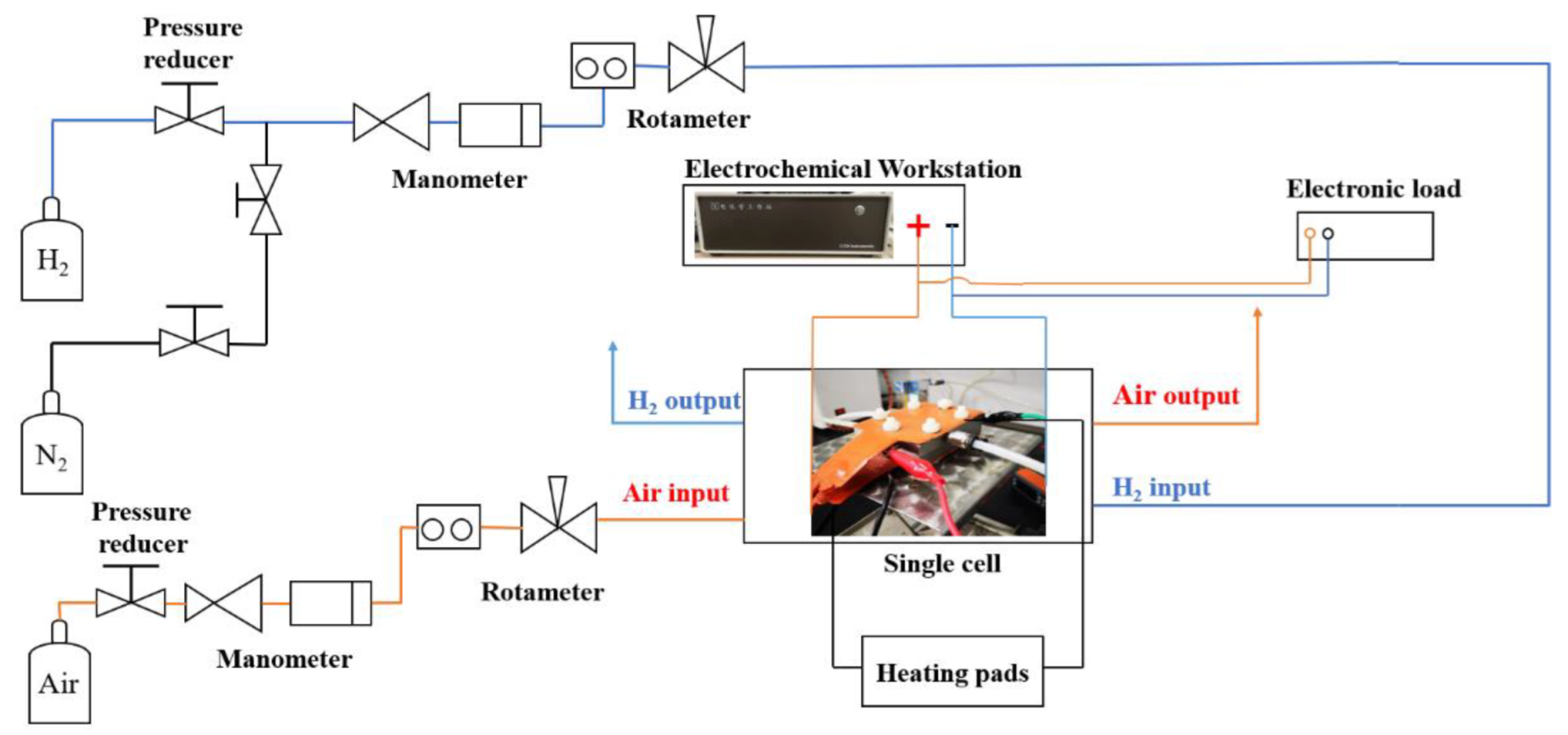
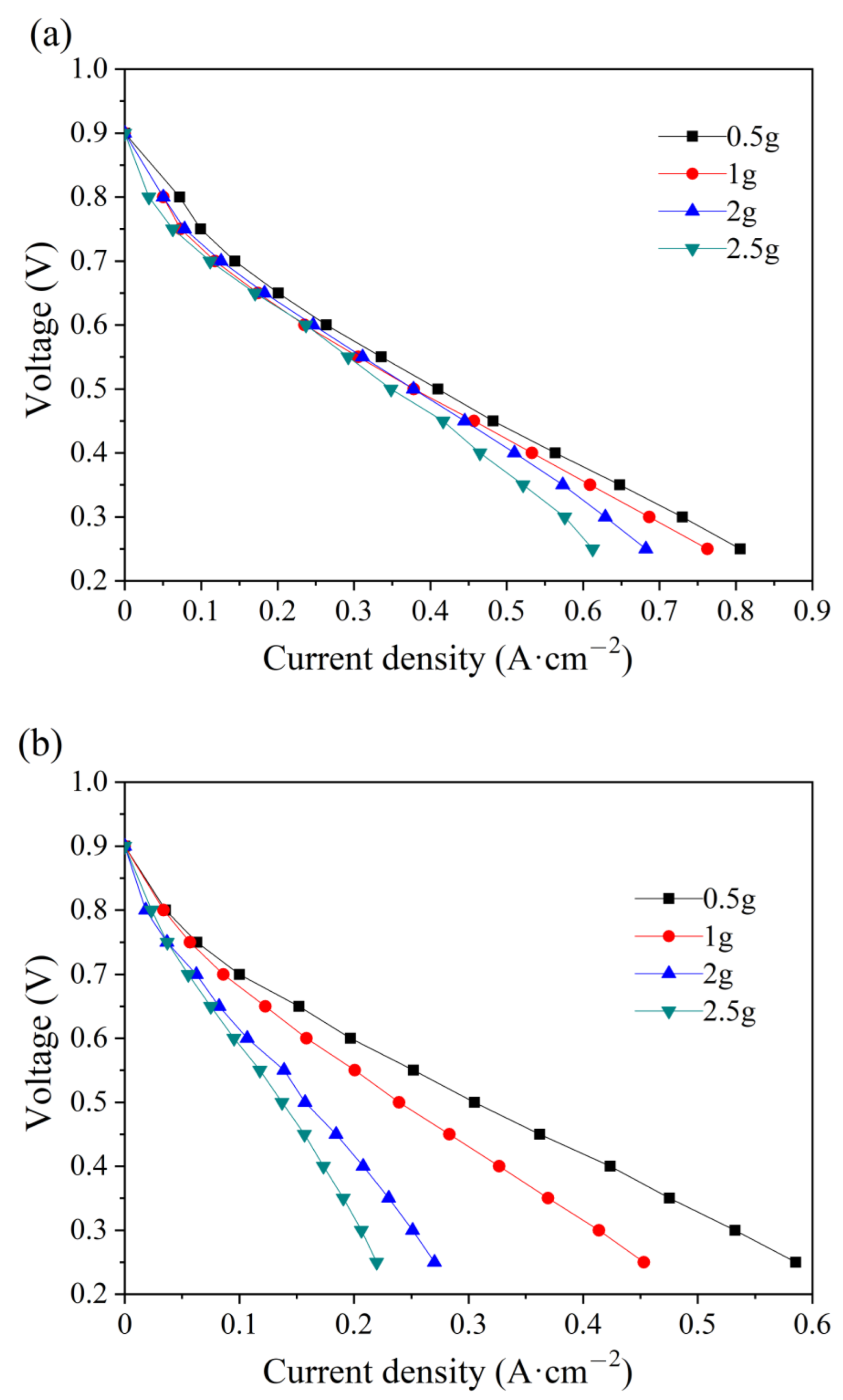


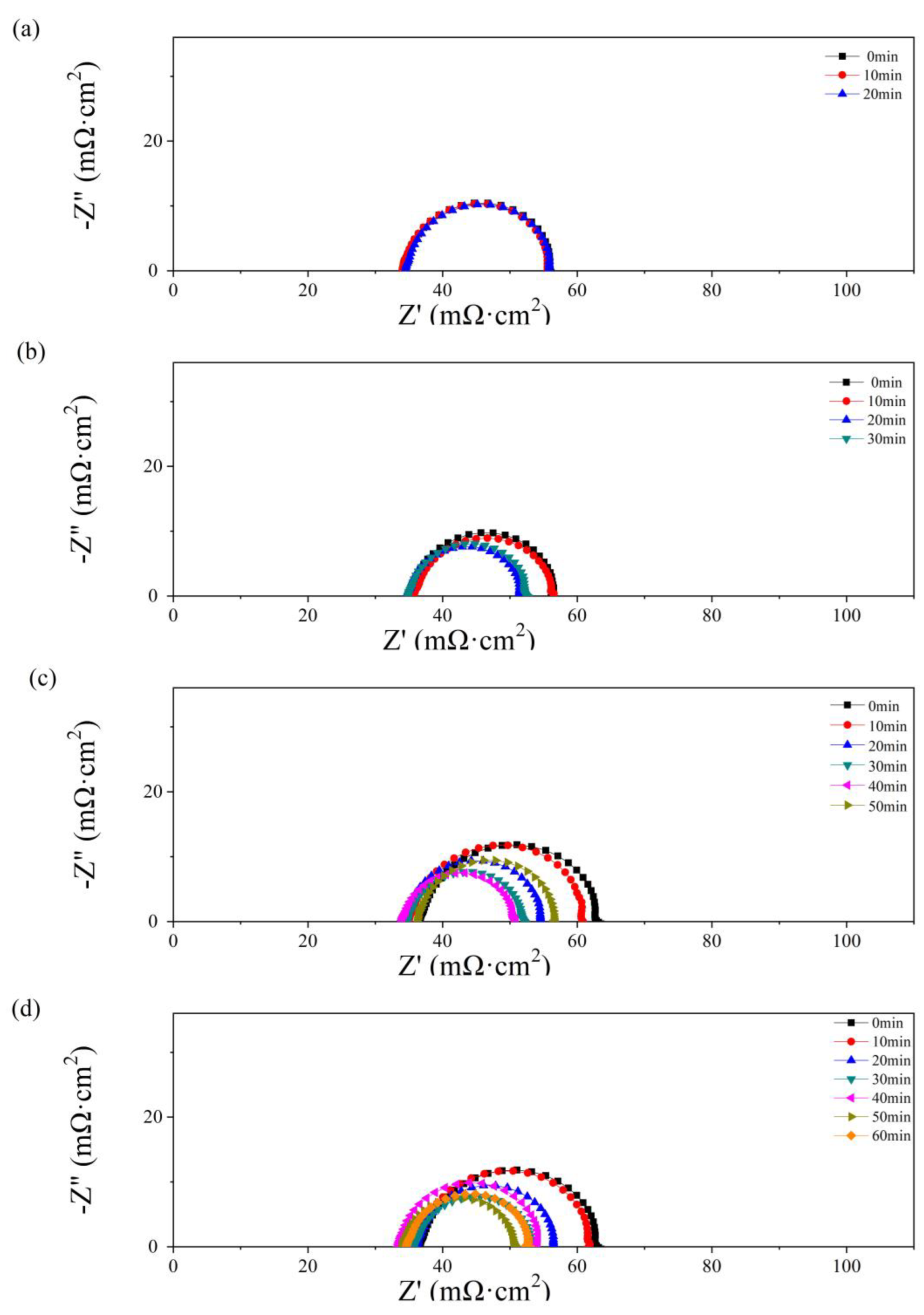
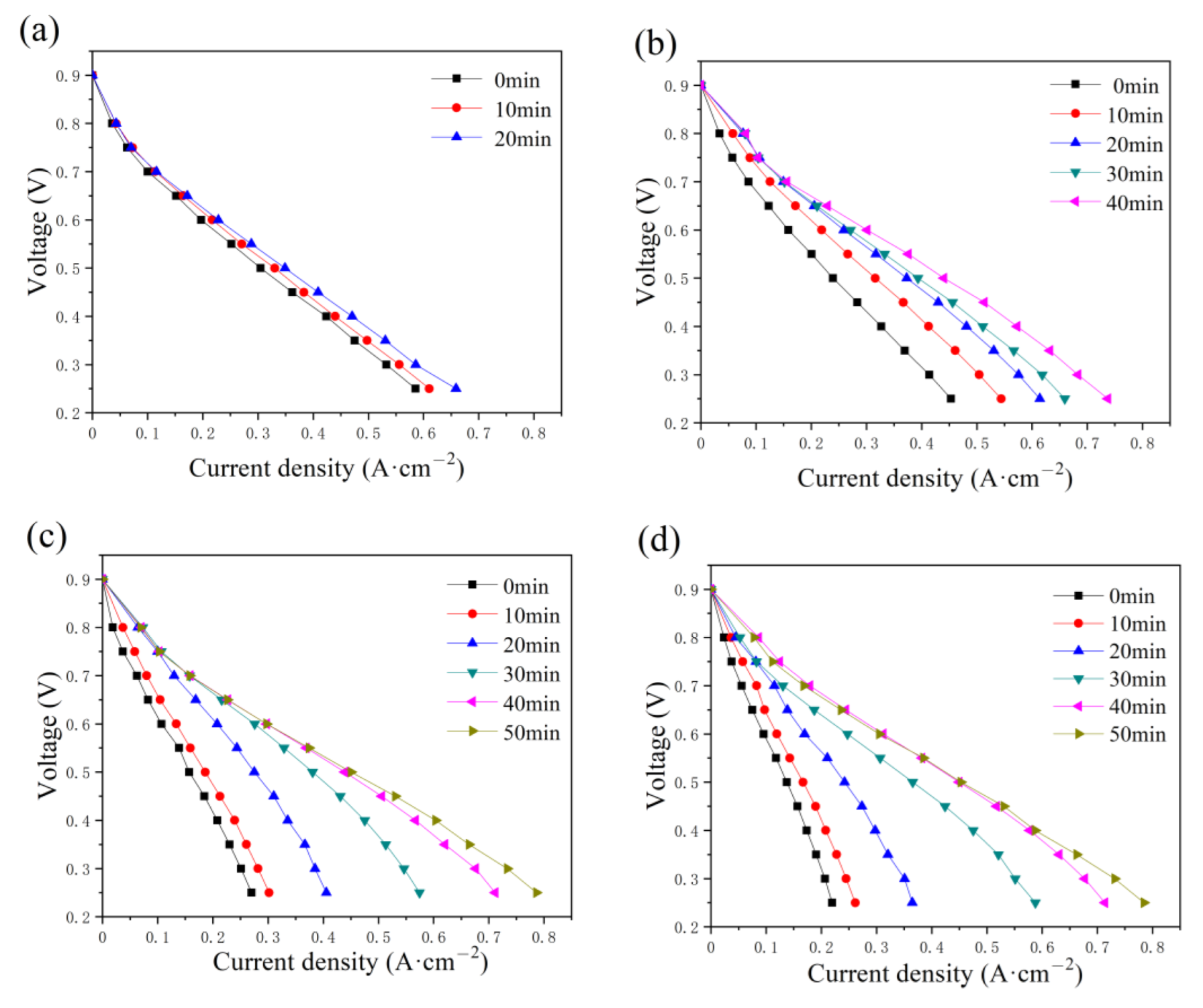
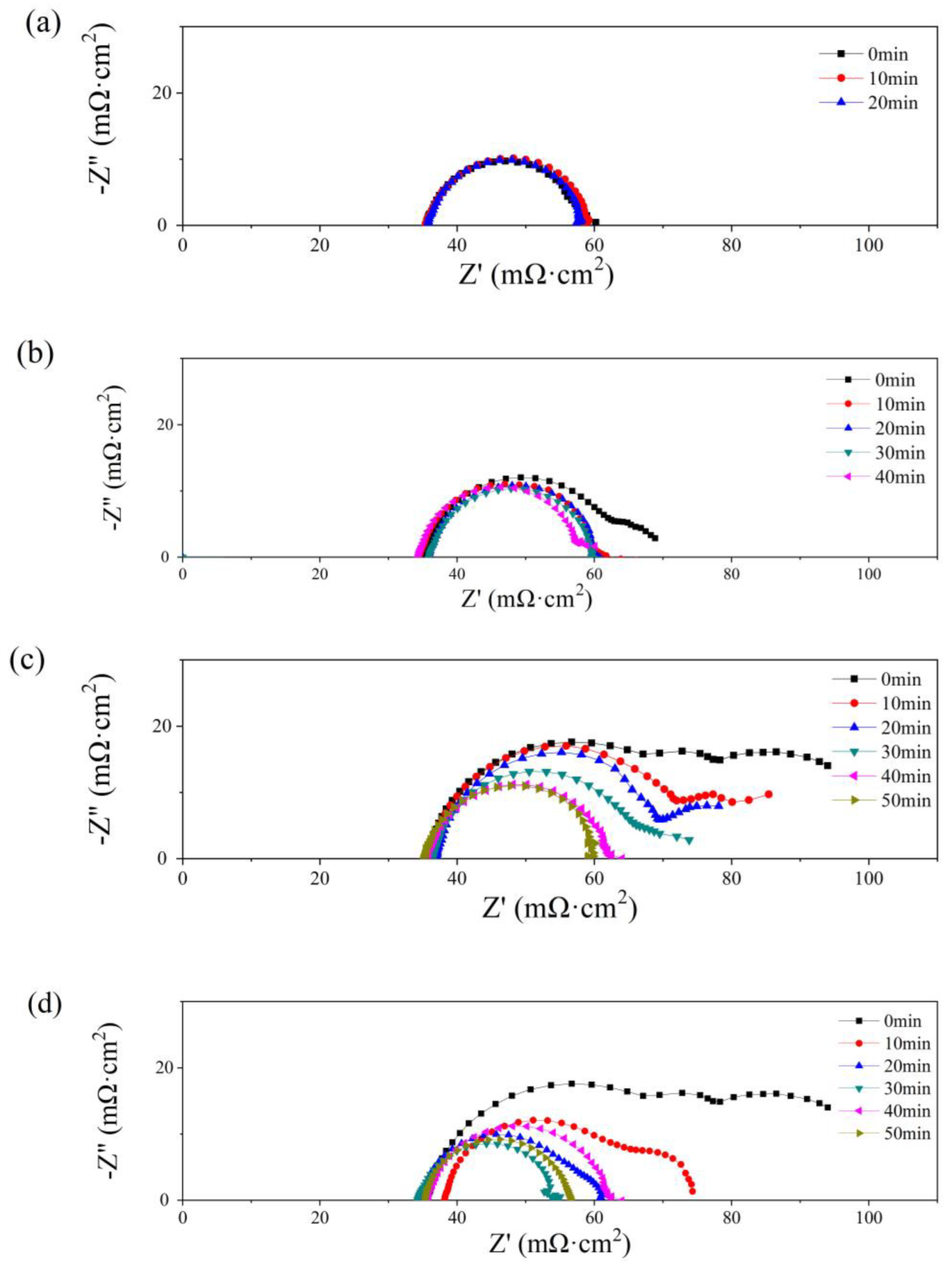
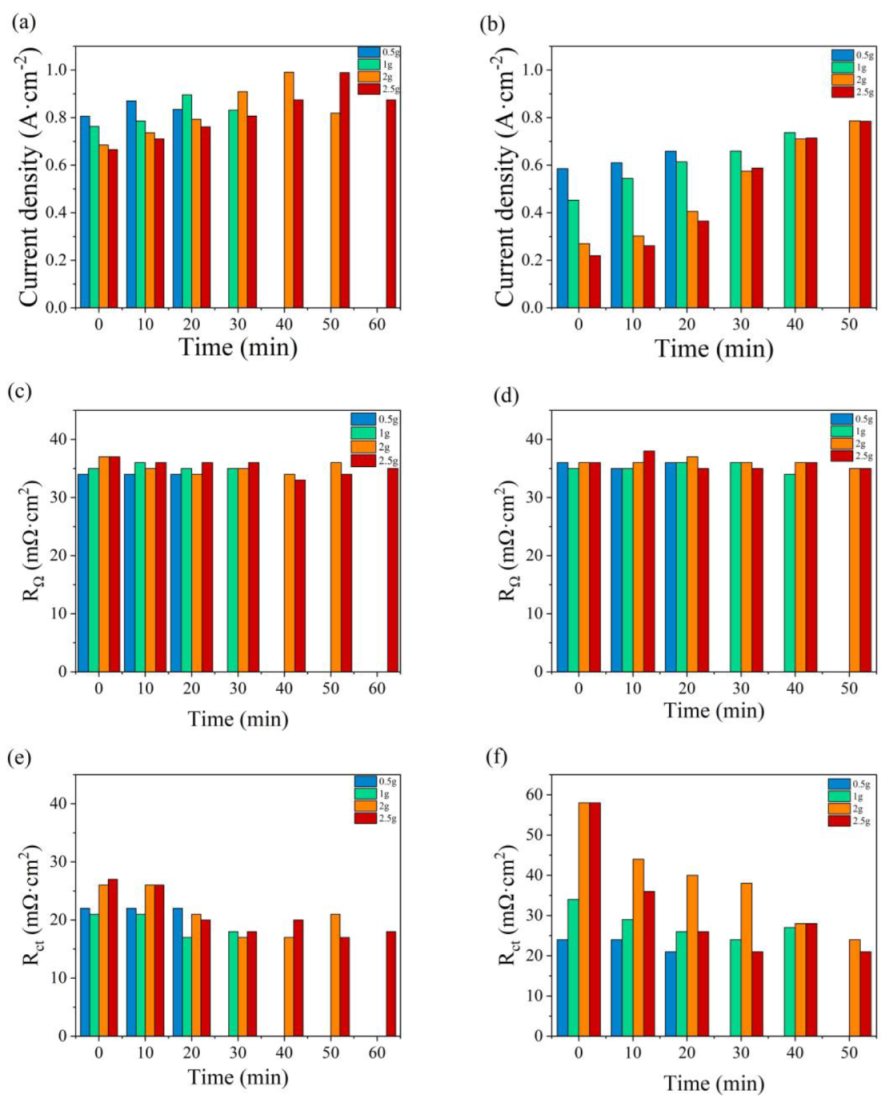
| Water Amount/g | T/min | RΩ/mΩ cm2 | Rct/mΩ cm2 |
|---|---|---|---|
| 0.5 g | 0 | 34 | 18 |
| 10 | 34 | 22 | |
| 20 | 34 | 22 | |
| 1 g | 0 | 35 | 18 |
| 10 | 36 | 21 | |
| 20 | 35 | 17 | |
| 30 | 35 | 18 | |
| 2 g | 0 | 36 | 11 |
| 10 | 35 | 26 | |
| 20 | 34 | 21 | |
| 30 | 35 | 17 | |
| 40 | 34 | 17 | |
| 50 | 36 | 21 | |
| 2.5 g | 0 | 39 | 30 |
| 10 | 36 | 26 | |
| 20 | 36 | 20 | |
| 30 | 36 | 18 | |
| 40 | 33 | 21 | |
| 50 | 34 | 17 | |
| 60 | 35 | 18 |
| Water Amount/g | Tcp/min | RΩ/mΩ cm2 | Rct/mΩ cm2 |
|---|---|---|---|
| 0.5 g | 0 | 34 | 26 |
| 10 | 35 | 24 | |
| 20 | 36 | 21 | |
| 1 g | 0 | 36 | 30 |
| 10 | 35 | 29 | |
| 20 | 36 | 26 | |
| 30 | 36 | 24 | |
| 40 | 34 | 27 | |
| 2 g | 0 | 36 | 44 |
| 10 | 36 | 44 | |
| 20 | 37 | 40 | |
| 30 | 36 | 38 | |
| 40 | 36 | 28 | |
| 50 | 35 | 24 | |
| 2.5 g | 0 | 42 | 55 |
| 10 | 38 | 36 | |
| 20 | 35 | 26 | |
| 30 | 34 | 21 | |
| 40 | 36 | 28 | |
| 50 | 35 | 21 |
Disclaimer/Publisher’s Note: The statements, opinions and data contained in all publications are solely those of the individual author(s) and contributor(s) and not of MDPI and/or the editor(s). MDPI and/or the editor(s) disclaim responsibility for any injury to people or property resulting from any ideas, methods, instructions or products referred to in the content. |
© 2023 by the authors. Licensee MDPI, Basel, Switzerland. This article is an open access article distributed under the terms and conditions of the Creative Commons Attribution (CC BY) license (https://creativecommons.org/licenses/by/4.0/).
Share and Cite
Chen, L.; Wang, Z.; Sun, C.; Zhu, H.; Xia, Y.; Hu, G.; Fang, B. Water Management Capacity of Metal Foam Flow Field for PEMFC under Flooding Situation. Micromachines 2023, 14, 1224. https://doi.org/10.3390/mi14061224
Chen L, Wang Z, Sun C, Zhu H, Xia Y, Hu G, Fang B. Water Management Capacity of Metal Foam Flow Field for PEMFC under Flooding Situation. Micromachines. 2023; 14(6):1224. https://doi.org/10.3390/mi14061224
Chicago/Turabian StyleChen, Lingjiang, Zichen Wang, Chuanfu Sun, Hui Zhu, Yuzhen Xia, Guilin Hu, and Baizeng Fang. 2023. "Water Management Capacity of Metal Foam Flow Field for PEMFC under Flooding Situation" Micromachines 14, no. 6: 1224. https://doi.org/10.3390/mi14061224







